How to Make Yogurt
Oct 26, 2011, Updated May 01, 2016

I spend a lot of time in the kitchen. Even when it’s not October #Unprocessed, I make a ridiculous number of things from scratch.
I tend to get a little pushy when it comes to making your own yogurt. Frankly, I think everyone should do it! If ever there was a homemade yogurt pusher, it’d be me.
I don’t need a trench coat (“Wanna buy some yo-gaht?”) to push this deal. Yogurt is one of the many from-scratch practices that saves a ton of money over buying it at the store. My family of four eaters, two of whom are under seven years old, goes through a gallon or two of homemade yogurt per week — no exaggeration.
With current milk prices of about $3-ish per gallon and a 32-oz. tub of plain yogurt ringing in at $2-3, I figure I save $600-800 per year just on this one food. Plus, I’m always pleased as punch to see healthful probiotics going into my kiddos, especially during cold and flu season.
Each batch takes only about 17 minutes, split up into four parts. I’m willing to teach you my secret method, but only if you promise to eat yogurt with as little sweetener as possible. 😉
The basic steps of yogurt-making…
…are easier than chocolate chip cookies:
- Heat to sterilize the milk (185 degrees).
- Cool milk to proper incubation temperature (90-120 degrees).
- Add starter yogurt.
- Incubate at warm temperature 4-24 hours.
Supplies
- Glass jars (quart canning jars or empty mayo or spaghetti sauce jars work great)
- Milk (any, from skim to whole – but skim will be very runny unless you add powdered milk, which seems a little #processed for this challenge. You could always just grab raw milk straight from the cows!)
- Candy thermometer, but I can show you how to do it without one too
- Pot large enough to hold your glass jars
- 2 Tbs of plain yogurt per quart of milk (Buy the freshest yogurt possible at a store and make sure it has “live and active cultures.” I prefer Dannon or Stonyfield. I know they have the three top cultures that I’m looking for to help the gut.)
- Picnic cooler
- Bath/beach towel
- Timer
Method
1. Put a dishcloth in the bottom of a large pot, and place the clean jars on the cloth.
2. Pour milk into your jars to about an inch from the top.
3. Place jars into the pot and fill pot with tap water around the jars.
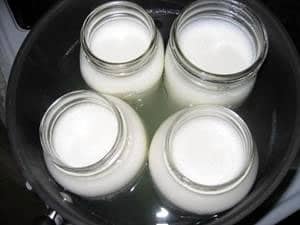
4. Cook on high heat until boiling and get the milk to about 185 (you can’t burn it with this method, so if you forget it for a while, it’s OK!). Turn off the heat and put lids on the jars.
5. Put the pot in the cooler with the towel underneath and the lid on both pot and cooler.
6. Cool the milk. You can do it on the counter, in the garage in winter, or in a sinkful of cold water with ice packs.
7. Get milk to about 110 degrees. I know the milk is about ready when I can pick up the jars and hold them without burning my hands.
8. Stir in ~2 Tbs. plain yogurt for each quart of milk.
9. Get those lids on again and nestle your jars in the cooler. Keep them wrapped in one half of the towel and take the lid off the pot to let the heat out, then close the lid of the cooler to keep the heat in.
My yogurt jars happily nestled in the cooler, ready to incubate.
Before I close the lid, I’ll wrap the towel end from the right around the jars.
10. Incubate 4-24 hours. Shorter incubation makes sweeter yogurt, longer is more tart. Also lower incubation temperature makes sweeter yogurt and higher makes more tart. I’ve had good success at 4 hours and at 24 (add a teapot of boiling water at the 12-hour mark if going for the full 24, which gets rid of almost all the lactose in the milk).
11. When the time is up, put the jars into the freezer for about an hour to make a creamier consistency. Do not stir first. No room in the freezer? They can go right into the fridge.
That’s it! You have created yogurt!
More Information
- If you’re nervous and would like more detailed instructions for the yogurt, my post on making homemade yogurt leaves out no details.
- I know a lot of people make slow cooker yogurt, but I hate dishes so much that washing that big insert just kills me. I’d rather dump the water out of my pot to air dry, put my cooler away and be done.
- Missing cream cheese during October #Unprocessed? You can hang your yogurt to drain out the whey, and the result is almost identical to cream cheese.
- What can you do with homemade yogurt? See this list of homemade yogurt recipes.
- Here are my top four tips for eating less sugar in your yogurt.
- Want to learn even more? Check out the GNOWFGLINS eCourses on Cultured Dairy & Cheese Making and Fermented Foods.
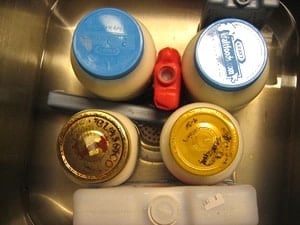
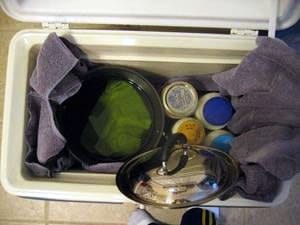

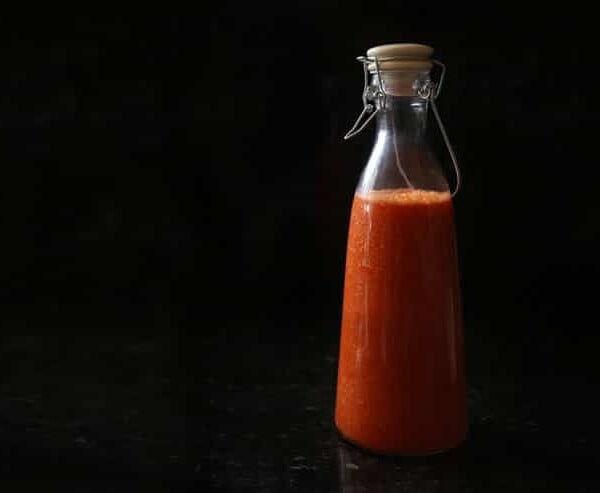

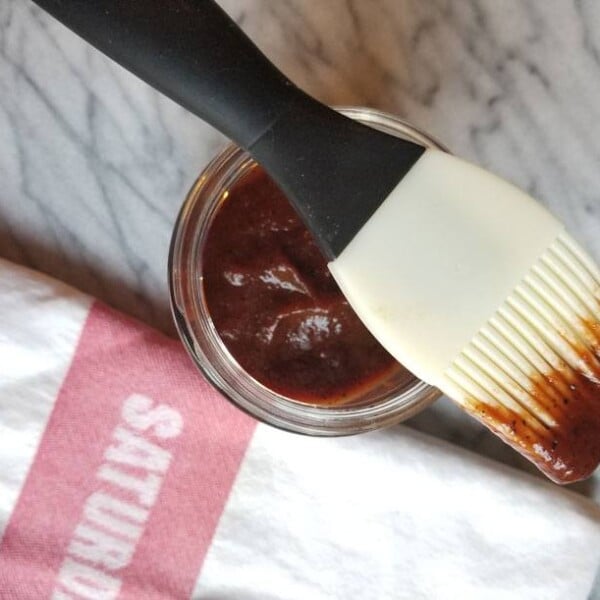
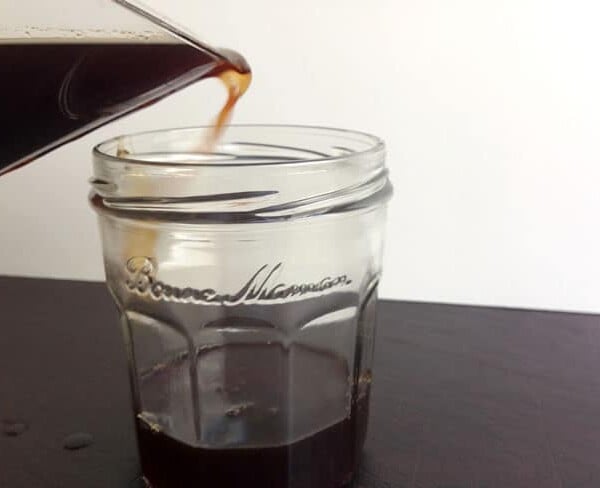















I make mine in my large crockpot. I wrap my crackpot in large towels and fleece . With my crockpot on low. I cover the top with towels after 2 1/2 – 3 hours it is at 178-180. Unplug crockpot. I take the lid off and let it cool to 120.take two cups of the cooled milk out and mix with the yogurt until there are no lumps and add it to crackpot cover with lid and towels and leave overnight. Remove invert from crockpot and chill and eat. For fruit flavors I puree fruit and freeze in ice cube trays. The kids microwave the ice cubes and mix with yogurt and eat.
I’ve been wanting to try this for a while now, but have been reluctant to spend the money on one of those yogurt makers (and what do you do when the power goes out?). I’m definitely going to give this a try–we go through a lot of yogurt with three people who eat it regularly. Here’s hoping!
I’m surprise no one has mentioned this yet, but there is so way you can put hot jars in cold water, they crack! I should have thought of this (as I’ve had pyrexs shatter in the oven if I add cold liquid), and just tried to make yogurt following your instructions, but my jars all broke in the sink!
Next time, I’ll just leave them on the counter to cool.
Melissa,
Oh, dear, I’m so sorry I was sharing the condensed version here. When I describe every breath of the process, I do say that I put the jars in an empty sink and slowly add cold water. Every so often I break one, but not every time. I always cool on the countertop unless I’m in a time crunch, if only because it’s one less step and saves water. Sorry you lost your jars and milk! 🙁
Katie
Thank you Melissa, I can avoid this because of you
Forgive me, Katie Kimball, for saying this: the amount of energy and time shown spent on making your ‘kind’ of yogurt may very well equal that of putting man to Mars.
I am from India. I eat fresh, homemade yogurt twice everyday without fail. Only 10 min process time, and voila! 8 hours later, I have a tub of yogurt as creamy as vanilla icecream.
185 to 110 degrees…God damn! Whew!
I make mine in a thermos. In the evening heat the milk to 185 in the microwave, cool to ~115, stir in starter yogurt, pour into pre-heated, high quality thermos. That’s it. By morning you’ve got yogurt!
I have been following Katie from nearly the beginning of her blog, and this is the one recipe I failed nearly every time on…Unfortunately as it saves dishes, it doesn’t save me money or time considering my failed attempts. I have much better success with the “milk heated to 185 on stove, cool in sink to 110, mix in yogurt “starter” and then cool/incubate in a warmed Crockpot for 8 hours method. It just works every time for me. Figure out what works best with your style/altitude/familytastes/etc and go with it. No matter which way you do it, it’s so much more affordable than store bought. I just found your 100 days challenge today with a link up from Katie’s webinar she did today. I’ll be back for sure!!
I’ve enjoyed reading your process and the following posts. I’ve been making my own yogurt successfully for years, and my ‘new’ favourite preferred incubator is a cold oven, place your covered jars of milk inside, turn oven light on…and voila in the a.m. (about 8 to 10 hrs) it’s yogurt. I look for homoginzed milk when it’s on sale 50% off….a couple of hours before going to bed…heat it to 185 degrees..takes about ten minutes so not to scorch…set aside to cool to the 110 degrees…I do add 2TBL of instant skimmed milk powder per litre of milk, and 2 TBL of room temperatured previous batch of yogurt…whisk..do my oven thing. I love it! I make one litre or three litres….what a bargoooon when milk is 50% off!
Grace,
I’m happy to help you troubleshoot, and there’s a “this happened/maybe that was the problem” list at the homemade yogurt tutorial back at my blog. Once you get it down, though, it’s easy!
🙂 Katie
I have tried to make yogurt, and it was a huge fail. I don’t know what I did wrong. 🙁